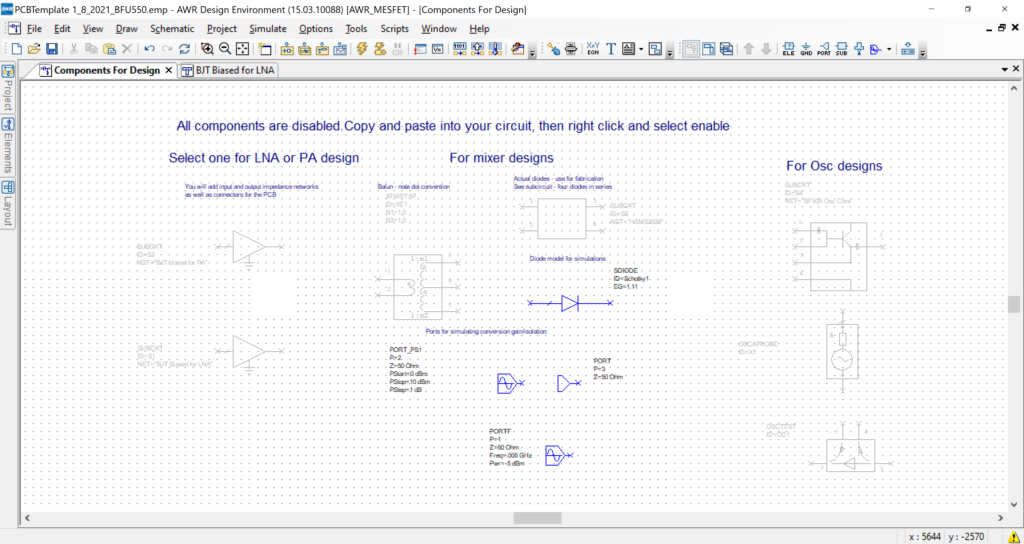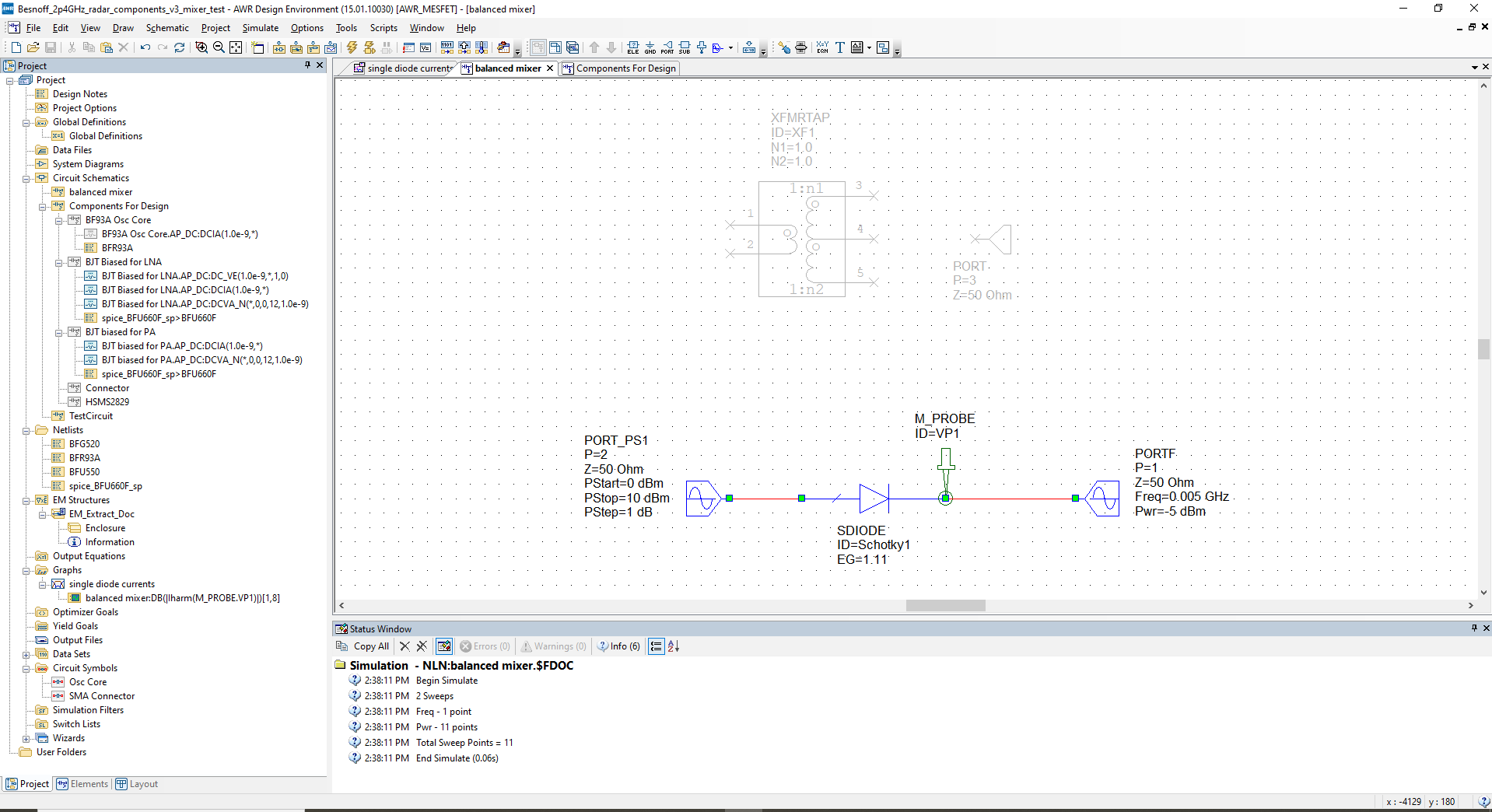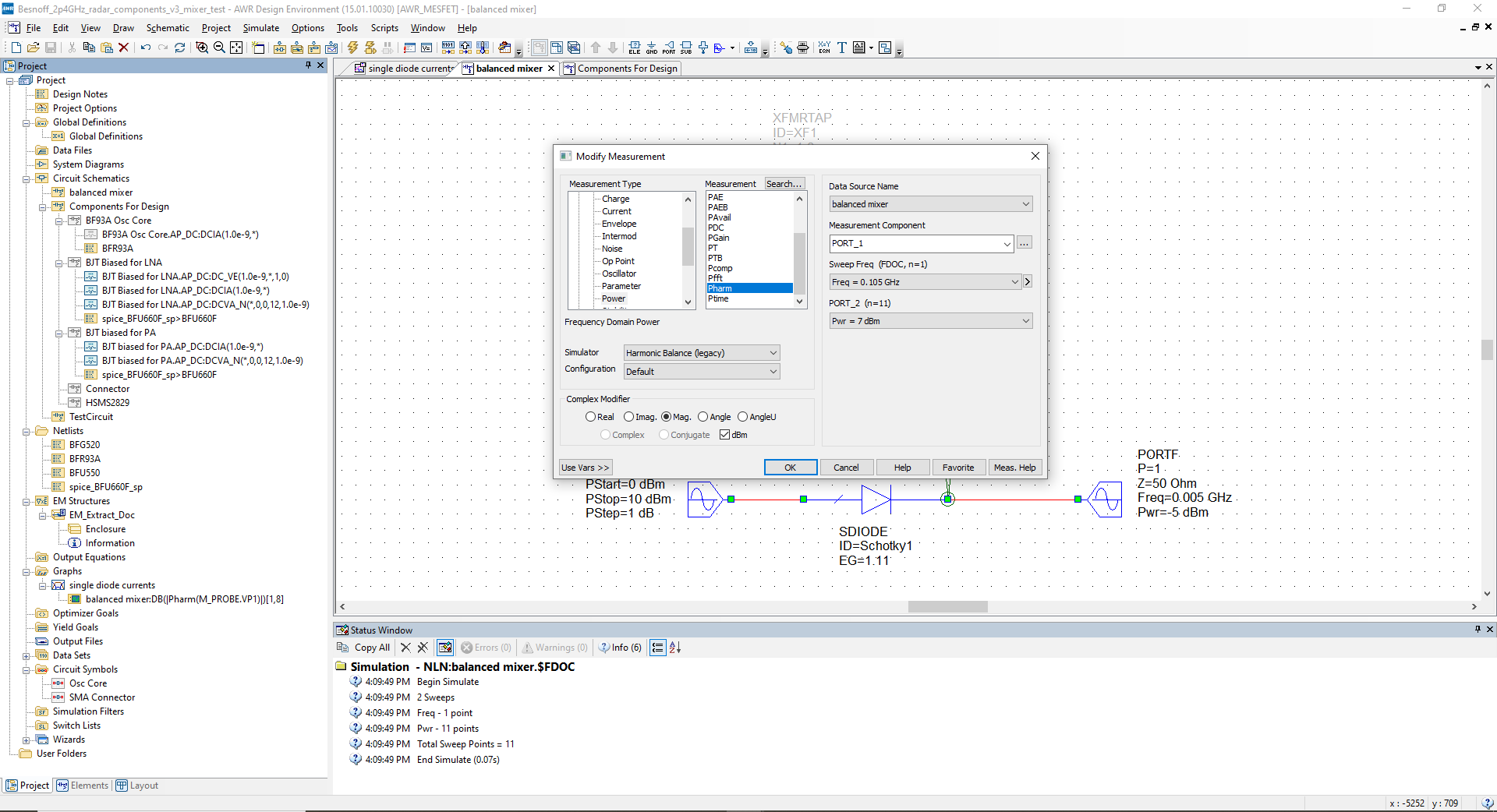

Balanced Mixer
Balanced Mixers
The branchline mixer is based on a balanced mixer design. In this design we will learn how a single diode mixer works and then extend it to a balanced mixer. Once you have the understanding of operation, we will build a Branchline balanced mixer.
Part 1– Single Diode
Open the Template file. Under the Projects Tab on the left you will find Components for Design, which will be similar to below depending on your template version.

The components are disabled. You can enable them by right mouse-clicking and Toggle Enable.
The blocks are:
- XFMRTAP – This is a simple transformer with turns ration n.
- SDIODE – This is a Schotky diode, a type of diode with a low turn-on voltage
- PORT_PS1 – This is a 50 ohm port, like a VNA, that will sweep the input power from PStart to PStop in PStep. In this lab we use 0 to 10 dBm in 1 dBm steps.
- The frequency of the input is not explicit but rather is implicit and is set by going to Options->Project Options and selecting the Frequencies tab. Select Single Point then type in 0.105 in the Point box and hit the Apply button. You will see it appear on the left box under Current Range.
- PORTF – This is a 50 ohm port, like a VNA, that has a specified frequency and input power. It is set for 5 MHz and -5 dBm.
- PORT – This is a 50 ohm port, like a VNA. It does not have any input power, but rather is used for measuring and 50 ohm termination.
Create a new schematic from the menus on top: Project->New Schematic. Name it “balanced mixer”. Return to the template and disable the components (as they are not connected and could prevent simulation).
Create the following schematic.
We are going to start by setting up a simple diode with two ports. Assemble the following schematic.

You can find the Measurement Probe at the top of the screen. Make sure to add it to the pin and not the net (to have it measure current)

Please make sure the ports are using the same numbers as the example (P=#). Start with P=1. The software requires that the ports be sequential and start from 1. See the bullet list for the port number for each port.
For Simulation Only: we will use the frequencies of the example in the Theory of Operation for educational purposes. The double balanced mixer does not have any narrowband components, and therefore works over a broad bandwidth. We will simulate at 105 MHz, however it will operate properly in our radio at 950 MHz.
The frequency of the LO port, PORT_PS1, is not explicit but rather is implicit and is set by going to Options->Project Options and selecting the Frequencies tab. Select Single Point then type in 0.105 (units are GHz, so this is 105 MHz) in the Point box and hit the Apply button.
The frequency of the IF is set explicitly in the port definition of PORTF at 5 MHz.
We use these frequencies for demonstration purposes. In the frequency of the branchline mixer is determined by the branchline design, not the balanced diodes.
The frequency at the RF port, P=3 is not set, as this will be our output.
To start, we will examine the currents in one diode to see the different harmonics that are present. To simulate, we first need to create a graph. From the top menus: Project->Add Graph->Rectangular and label is “single diode currents”.
Once the graph appears, Right-mouse Click->Add Measurement. Then the following box appears:

Please set the following (you can check the image to verify all settings are correct):
- Measurement Type: Nonlinear->Current (selects a simulation that will have harmonics since it is nonlinear and that we will be plotting some function of the current)
- Measurement: Pharm (this will plot the harmonics of the current)
- Data Source Name: Select the name of your mixer schematic “balanced mixer”. Make sure it is not All Sources (default) or one of the other subcircuits in the template.
- Measurement Component: Select M_PROBE (not PORT_1 as shown in the image). Make sure M_PROBE is on the pin, not the net!
- Sweep Freq: 105 MHz, this will use the project options you setup earlier for 105 MHz.
- PORT_2: the setup sweeps the power on the LO port. Set this to 7 dBm for a fixed LO power.
- Simulator: Harmonic Balance – this will simulate the 105 MHz and all sums/difference harmonics.
- Complex Modifier: Mag. In dB
Hit the simulate button (the lightening bold on the top menu). The results are below.
The current spectrum will look like the plot below.

The frequency components are 105 Mhz for the carrier and 100 Mhz and 110 Mhz for the sum and difference from the mixing. The sum and difference frequencies are -16 dBm. The 5 Mhz signal is also seen. (plot below is not necessary for grade – just an FYI)
We now need a way to extract the RF signals we want from the diode current. One way to do this is have a path for the IF current that is separate from the RF current. Since they are at very different frequencies (100 and 110 Mhz vs. 5 Mhz) a simple filter will do. Construct the following filter, also known as a diplexer.

The low frequency component (including any DC bias) will pass through the inductor to the IF port. The RF frequencies will pass through the capacitor to the RF port. All currents will pass through the LO port.
Set the LO=7dBm and plot the spectrum of the current at the RF port. It should look like below.

The conversion gain is -16.8 dBm –(-5 dBm)=-11.8 dB. Isolation: 7 dBm-(-3.2 dBm)=10.2 dB.
Now plot the conversion gain versus input power on the LO.
Add another graph with the following measurement.

This is measuring the large signal S parameters from IF (P=1) to RF (P=3). The Harmonic Index tells the graph which harmonic to plot. The -1 and +1 are indices for the harmonic. If you click on the “…” shown in blue above, a window will appear. Select the 100 MHz harmonic, and the indices will be selected on top for you. The meaning of the indices is not needed for this project, you just want to ensure you will plot the 100 MHz harmonic. Note: we could have also plotted the 110 MHz component, as it is the other sideband of the RF signal. Likewise, we select 5 MHz for the bottom Harmnoic Index as that is the harmonic of the input. The logic of which one to select, is just top-down, since PORT_3 is top, the top Harmonic Index is 100MHz. The bottom is PORT_1, and so the bottom Harmonic Index is 5 Mhz. Both match the ports they refer to.
The only other change is for PORT_2 – change this to “use for x-axis”. Note: you may have to scroll UP to get to it. This setting will plot the PORT_3 signal (RF) power at 100 MHz corresponding to the 5 MHz input at PORT_F (IF) versus LO power on PORT_2.
The results are below.

Plot the isolation between the IF to RF and LO to RF. Use the same technique as above, except add LSSnm lines for LO to RF port. Choose harmonics for both so that it is 105 Mhz (the LO freq). You can click the “…” to next to the Harmonic Index to see how the Index corresponds to a frequency or you can just play with the up/down to make sure you get the correct frequency on both ports at 105 MHz. For the IF to RF, plot LSSnm but at the 5 Mhz harmonic (the IF frequency).

At LO=7dBm Conversion gain was calculated to be -11.8 which is approx.. same as on the conversion gain plot. The LO to RF isolation was 10.2 dB, which matches the Isolation plot
Part 2– Balanced Diode Mixer
Using your previous design, add another diode and transformer as shown below. This forms the balanced diode mixer discussed in lecture.

The spectrum of the current at the RF port for the LO=7dBm is shown below.

Conversion gain is -10.6 dBm –(-5 dBm)=-6.8 dB. Isolation: 7 dBm-(-58.5 dBm)=65.5 dB
Now plot the spectrum of the current through one diode. This can be done by adding a MProbe to one side of a diode and then plotting the Nonliner->Current->Iharm in a rectangular plot. Comment on the differences/similarities with the harmonic plot for the RF port.

The LO is clearly seen with a large value. This shows that the individual diodes have currents similar to the single diode mixer, however it is the cancellation of the currents at the summing node (where they are connected together) that creates the cleaner spectrum in the balanced diode mixer.
The conversion gain is shown below along with the isolation.


You have now designed a balanced mixer.
Continue to the Branchline design, where you will design a Branchline coupler that will replace the idea Balun (transformer) in the balanced design we have done.
The final step is to complete the mixer on the Branchline Mixer page.